|
|
Bride of Horror List
|
||||||||||||||||||||||||||||||
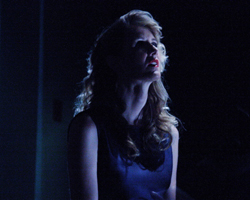 25) David Lynch's Inland Empire
25) David Lynch's Inland EmpireWhy it's on the list: Every critic's list has to have a David Lynch film, right? Isn't that the law? Why you might be saying "Oh, hell no!": This is the first time you've ever heard of this movie. --Is this the saga of a down on her luck actress on the set of a "cursed" movie production who unwisely takes up with her co-star despite having an insanely jealous husband at home? Is it a meta-commentary on the narrow spectrum of roles available to actresses in Hollywood (wife, mother, prostitute, mistress?) Is it all playing on a television in a crappy apartment somewhere in Poland? Does the action spill over two continents and several decades or does it all take place in the time it takes Grace Zabriskie to point and Laura Dern to turn her head? Are all of the film's events occurring simultaneously? In once again giving life to a tale that seems to have been skillfully crafted from his dreams, obsessions, and nightmares, Lynch allows for all these possibilities and more. Taken as a companion piece to Mulholland Dr., Inland Empire is at times even more fractured in structure, more unsettling in its indictment of the Hollywood Dream Factory, and more assured in attempting to shoehorn in every possible genre under the sun. There seem to be infinitely more interpretations on how to consider the sprawling, episodic, hyperlinked tale(s) that unfold over the mammoth - but never punishing - 179 minute running time (and how pleasingly and appropriately perverse is it that Lynch would stop just shy of a full three hours?) I once again resisted the temptation to read an analysis of the various plot strands to help me to make sense of things. I much prefer to chew on the various facets for many viewings to come. But why does this get my vote for the best horror film of the last seven years? Shooting on a cheap digital camera, Lynch creates suffocating darkness and shadows that are matched equally with overpowering lights both natural and artificial. (I cannot recall another film that makes a brightly lit room look as terrifying as a darkened staircase or blind alley.) There is a nameless, pulsating dread that infuses every scene, which allows the moments of true terror to strike unexpectedly in the midst of sequences of agonizing tension. Watching this at home by myself was scarier than the two times I saw it in the theater. Dern has admitted that she would often have no clue what was going on plot wise at any particular moment and relied on Lynch for guidance as to the emotional tenor of a scene. No matter. Her performance(s?), goes far beyond acting to fully inhabit a spectrum of emotions and states of mind. All this plus two of the goofiest, most unexpected musical numbers in modern memory to boot. If Mulholland Dr. was a mystery transformed into a tragic tale of lost love, Inland Empire is an epic of unease and paranoia that gradually stumbles towards cathartic release. Lynch finds a way to send his characters and the audience - with a wink - into the light. (Brett Beach/BOP) |
|
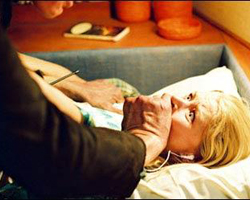 24) The Hills Have Eyes (2006)
24) The Hills Have Eyes (2006)Why it's on the list: We like radioactive mutants. Why you might be saying "Oh, hell no!": You like character development. --Remakes are always a dicey proposition. They are always a money grab and run the risk of being cynical and lazy hoping that the familiar title alone will be enough to grab a big opening weekend, quality be damned. The horror remake landscape is littered with almost as many corpses as appear in the movies themselves. That's why The Hills Have Eyes (2006) was such a pleasant surprise. The key to the movie's success was bringing on board Alexandre Aja as writer/director along with his writing partner Grégory Levasseur. They had previously made Haute Tension, a horror film that although marred by an incomprehensible final five minutes was incredibly stylish, suspenseful, and something of a throwback slasher flick itself. Aja's talents melded perfectly with the very simple tale of a family who gets stranded in the middle of nowhere surrounded by a psychotic mutant family. The bare bones plot allows Aja to focus on style and creating frightening and gripping set pieces, and an especially appealing cast draws you in and allows you to relate to the characters more strongly than often occurs in a horror film. The remake spawned a greatly inferior sequel, but before that Aja was able to take inspiration from a previous work to craft a new classic of the horror genre. (Dan Krovich/BOP) --An overview of the horror genre in the interim since our last piece largely involves three phases. We have the Asian adaptations/remakes phase wherein films like The Eye and The Grudge draft off of the success of The Ring. Then, there is the gorno phase where somebody gets their eye pulled out in Hostel and a bunch of other misanthropes copy that premise. Okay, that's not completely true as the first film categorized as gorno makes our list in just a moment, but you understand my point. The final phase features remakes of classic horror staples from the 1950s-1980s. Once our list is fully revealed, you'll note that exactly one Asian remake and one gorno has been selected. Only two remakes of American classics are selected and this is the first of those. Why does The Hills Have Eyes merit inclusion? Any long time reader of BOP realizes that our preference as a group is that of substance over style as a rule. We like meat and potatoes more than extravagant, fattening desserts. With one exception. The purpose of a horror movie is to scare the holy bejeezus out of the viewer. This is the rare case where not only is style over substance an acceptable option but even the preferred choice. Keeping this in mind, director Alexandre Aja stands at the forefront of terror in the 2000s, first for his work in the shocking French flick, Haute Tension and later for this, his first studio system creation. Since there is a schism among our staff about the quality of Haute Tension (I personally loathe the film but several other writers here think it's the worst omission on our entire list), Aja's remake of the 1977 Wes Craven classic that narrowly missed inclusion on our first list became the obvious choice for selection. Aja's creepy exploration of a nuclear family (in the literal sense) terrorizing some parents who are traveling with their children has enough jump-inducing moments to make us never want to take a road trip again. Oddly, the movie Road Trip had a similar effect. While we were non-plussed by the quick sequel, The Hills Have Eyes is as straightforward as horror films get and it is stylized enough to hold our attention from start to finish. Plus, any film with a character named Papa Jupiter is aces by me. (David Mumpower/BOP) |
|
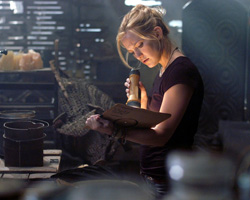 23) The Skeleton Key
23) The Skeleton KeyWhy it's on the list: For several years, every horror film had to have a twist ending. This one may have been the best. Why you might be saying "Oh, hell no!": You are M. Night Shyamalan and you got one-upped. --When a twist ending succeeds and "makes sense," I'm totally a sucker for it. This is true of a movie like The Skeleton Key. It worked for me in much the same way that Being John Malkovich did. Just suspend belief in, you know, reality for a few hours – or, I guess, believe black magic and/or supernatural forces to be true – and you're totally set. Simply, The Skeleton Key concludes in a way that I just didn't see coming. And because it kicked me in the backside – and, probably, had much fun doing so to many, many other people – I've got a certain level of respect for it that isn't true of a good number of other Hollywood horror releases. Along those lines, Gena Rowlands was an inspired choice to play the movie's stereotypical old but wise lady, Violet Devereaux. She's quietly devilish in demeanor, and in my mind deserving of more praise than she may have received. Her chilling turn in 2004's Taking Lives as Mrs. Asher was a kind of prep work for what she'd do a year later in The Skeleton Key. (Eric Hughes/BOP) --Hoodoo Voodoo has never been scarier than in this perverted tale of would be bodysnatching. A hospice nurse is invited to a classic southern plantation, asked to play Florence Nightingale to an elderly stroke victim. As the professional do-gooder, Caroline, learns more about her new client's very old home, a fear begins to gestate in her mind that the man's wife, Violet, may not want her husband to make a full recovery from his illness. Indeed, this woman appears to spend more time creating eerie voodoo dolls in her sewing room than she does doting on her husband. When Caroline confides in handsome attorney Luke that mayhap the woman wants to be a widower, Caroline is charmed into believing that her imagination has gotten the best of her. But has it? The Skeleton Key is as pleasant a surprise as there has been in the horror genre in the 2000s. Relatively unheralded prior to release, this title features a sublime cast that seems more likely placed in some Oscar bait film than one of plantation witchcraft. That's more of an Anne Rice thing, right? For whatever reason, Gena Rowlands, John Hurt and Peter Sarsgaard were all talked into starring in a movie with Kate Hudson. Hudson will always be a BOP fave for her performance in Almost Famous, but let's be honest here. Her prior movie was the forgettable Raising Helen and her next one was the heinous You, Me and Dupree. Even though Hudson was How to Lose a Guy in 10 Days away from being persona non grata in the industry, she kept getting script offers with The Skeleton Key being the quirkiest as well as the best career choice. The innocent ingenue looks she inherited from her mother play perfectly as she attempts to unravel the mystery of why Violet doesn't seem to have her husband's best interests at heart. The subversive streak that permeates throughout The Skeleton Key is that belief is not always a positive. Sometimes, a person is better served maintaining their skepticism, particularly with regards to the supernatural. When Hudson's character fails in this regard, well, I won't spoil it for you, but I will say that M. Night Shyamalan set back the suspense genre ten years when he made The Sixth Sense. Every other would-be auteur in the industry tried to mimic that film with their own big twist endings. Most of them fizzled out and a few were so poorly considered as to undo anything positive in those films. Not The Skeleton Key, though. This movie's reveal is masterfully hidden in plain sight as the viewer refuses to believe until it's too late, just like the film's heroine. I don't throw around the words often, but there is true genius at the end of The Skeleton Key. (David Mumpower/BOP) |
|
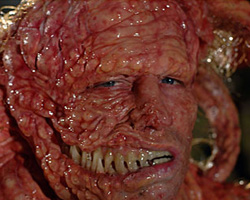 22) Slither
22) SlitherWhy it's on the list: BOP loves Nathan Fillion the way that Charlie Sheen likes hookers and crack. Why you might be saying "Oh, hell no!": Some critics say it's gory in lieu of being scary. --Slither is a throwback. It's part 1950s-era creature/monster feature a la The Thing, The Blob, or Invasion of the Body Snatchers. In that sense it would be easy, at first glance, to compare it to another classic throwback movie - Tremors. Like Tremors, it revolves around a small group of people in a small rural town who realize that they are facing a menacing force (instead of massive, prehistoric, subterranean snake-like creatures in Tremors, Slither features parasitic, alien, leech-like creatures) and they must either find a way to escape the certain-death or kill the creatures themselves. Like Tremors, Slither is at times a light-hearted soft-core horror movie that never takes itself too seriously and manages to have a sense of humor even when people are dying. And perhaps in spite of this, Slither is also part 1980s-era bloody and gruesome low-budget horror akin to Night of the Creeps, Re-Animator, or The Evil Dead. There is a lot of blood, a lot of gore, and a lot of over-the-top scares. My favorite part is when one young lady is taking a quiet bath (who takes baths instead of showers anyway?) and finds herself trapped in the bathroom by hundreds of the bloody little things. Perhaps these contradictions (light/dark, bloody/humorous) are why it never found popular success with mass audiences when it was released. It was a miss at the box office, and largely forgotten since, but this is a true horror movie. Led by dry-witted Firefly standout Nathan Fillion, the acting fits the nature of the movie very well. If you like any of the movies mentioned above, I urge you to give it a try. (Michael Bentley/BOP) --In the midst of the explosion of torture porn and '80s horror remakes, some of us yearned for the simpler days of scary movies. We remember watching midnight movie madness with wacky hosts like Son of Svengoolie on Chicago's WFLD, where we saw B-movie classics such as the Godzilla films, Universal's monsters, and other similarly awesome "creature features," as Sven called them. Slither takes us back to those wonderful, bygone days, with the simple story of a tycoon who finds himself infected by a space creature that has the evil intention to take over the entire human race. This plague slowly takes over a rural community by transforming its victims into zombies, all controlled by a central hive mind. It's up to a small group of heroes, led by the always awesome Nathan Fillion, to prevent the spread of the parasites and destroy the evil source. With such a goofy premise, you'd better hope that the dialogue is strictly tongue-in-cheek, and there is no doubt that Slither delivers on that front, thanks to the willing participation of Fillion, along with Elizabeth Banks, Michael Rooker, Jenna Fischer and Gregg Henry. It's not really a movie for the squeamish, but that's okay. If you're reading a list of favorite horror films, you probably aren't worried about that anyway. (Kim Hollis/BOP) |
|
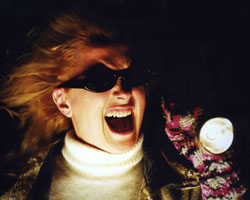 21) Night Watch
21) Night WatchWhy it's on the list: Most people say this is Russia's answer to The Lord of the Rings. We say it's Russia's answer to The Empire Strikes Back. Why you might be saying "Oh, hell no!": You can't pronounce any of the vampire's names and none of them are sparkly, either. --Every once in a while, a new movie will come from out of nowhere and absolutely blow your mind, reminding you why you love to go to the movies. For me, the first movie to do that since Memento was Night Watch, Timur Bekmambetov's epic fantasy-horror film. Russia's first blockbuster since the collapse of the Soviet Union pulls out all of the stops, and is one of the most visceral and visually intense movie going experiences I have ever had. The plot is almost an afterthought when you consider that there is a scene in which the villain removes his own spine and uses it as a sword. The story is about the relationship between a son and his father, a soldier in the battle of good against evil. It's very compelling, but mostly it is the awesome action sequences that make this film so incredible. It is downright terrifying at times, and proves that you don't need a big budget (by Hollywood studio standards) to make a great fantasy film. (Tom Houseman/BOP) --Nothing makes a child feel unwanted like finding out their parent tried to kill them. That's the basis for Night Watch, although it doesn't begin to scratch the surface of one of the most complex stories in recent cinema history. Yes, the movies and books are about vampires and yes, it's fair to say that their ubiquity in Eastern Europe parallels the popularity of Twilight here. The difference here, the primary reason we're willing to get all of the nasty hate mail for not selecting Twilight instead, is that Night Watch offers something utterly lacking in Stephenie Meyer's writing: creativity. This is an epic tale of a nearly eternal battle between good and evil that doesn't forget to cross the T's and dot the I's during its storytelling. And no matter what you may think of Timur Bekmambetov based on your experience with his North American films, 9 and Wanted, even his harshest critics must acknowledge that he knows how to make special effects feel special, a dying art in the current cinema landscape. Night Watch is complicated to the point of being borderline impenetrable at times. If you put in the work, however, you will be rewarded by an otherwordly tale of horror where good is not guaranteed to triumph in the end. (David Mumpower/BOP) |
|
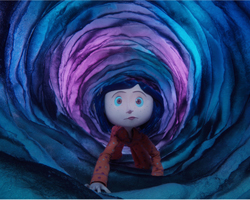 20) Coraline
20) CoralineWhy it's on the list: The Other Mother is one of the best movie villains in recent cinema. Also, BOP really wants Neil Gaiman to like us. Why you might be saying "Oh, hell no!": You may think that "scary cartoon" is a misnomer, but how many films have you seen where the bad guy not only steals children's souls but also their eyes? This is a truly twisted tale. --Word is that supposedly some screenings would end with parents saying something along the lines of, "I can't believe I took my children to see that," while the children would be ecstatic, saying just how awesome Coraline is. A twisted fairytale with elements of Alice in Wonderland and Hansel & Gretel, it's not exactly a scare-a-minute screamer of a horror film. Instead, it's not till the second half when things become monumentally creepy, as the stop frame animation brings to life things you've never even thought about. Once Coraline's "Other" Mother in the "Other" World becomes a frightening badass, there are ghostly children, missing parents, and a mechanical hand that makes an appearance in a thrilling final act. So far, it's also the best looking film I have seen in the 3D format - so much so that even though I own it, if I was to find it playing in 3D at the cinema, then I would pay to go see it. (Shalimar Sahota/BOP) --Coraline is a quirkily-drawn, beautifully colored, nightmarish animated film. Director/screenwriter Henry Selick adapted Neil Gaiman's novel into a non-traditional horror movie that was off the radar of the general movie-going public. Watch the film and you descend into a world of button eyes, ghost children and cotton candy cannons. Young Coraline stumbles into an Other-world that appears to be better than her own existence. But of course, treachery runs deep under the surface, and Coraline has to survive a labyrinth of horrors as desperately tries to escape. I still get a severe case of the willies when I think about the Beldam clawing its way after Coraline. After seeing the film, I always pay attention to what the Cat tells me, and am constantly on the look-out for a doll wearing a brightly-colored rain slicker. (Tony Kollath/BOP) --A number of people will claim that a children's cartoon has no place on a horror list. I beg to disagree. At the time of its release, I heard concerned parents commenting that they thought the movie looked too scary for their children. I think that we forget, however, that kids love to be scared, as long as it's done in the right way. I'm not talking about forcing a kid to watch Evil Dead, say, or Creepshow (which I accidentally let my sister watch when she was three-years-old. I think I irrevocably damaged her calm by doing so). But when faced with scary things like the Childcatcher from Chitty Chitty Bang Bang or the boat ride in Willy Wonka and the Chocolate Factory, kids are gleefully terrified. The same goes for Coraline, where the Other Mother and the world she weaves together are scary, scary, scary. Because ultimately, what child doesn't dream of "the perfect mother?" In the real world, moms are real people with real distractions and lives, but any child would be thrilled to find an "other mother" who would have the perfect answer to each question, who was willing to cook perfect spaghetti and who procured the perfect gifts. As we all know, of course, the grass is never greener over there. Beneath that shimmer of perfection lies a host of evil intentions. Coraline does indeed go through plenty of scares and frightful experiences, most notably the realization that she's expected to give up her eyes and her soul to live in the Other World – and that the Other Mother will hurt Coraline's parents if she doesn't stay. Try telling any child or grown-up that's not a scary story. I dare you. (Kim Hollis/BOP) Coraline Trivia Quiz |
|
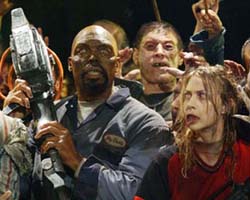 19) George A. Romero's Land of the Dead
19) George A. Romero's Land of the DeadWhy it's on the list: A horror list without a George Romero film is like a politician without a dozen skeletons in the closet. Why you might be saying "Oh, hell no!": You think Romero is 20 zombie films past his prime. --George Romero earned the nickname Grandfather of the Zombie Film honestly. With 1968's Night of the Living Dead, Romero not only introduced a more realistic, albeit grisly, element into the horror sub-genre, but also added the wrinkle of veiled social commentary to the mix. Romero had originally intended to make four Living Dead films, but after the less-than-boffo box office of 1985's Day of the Dead, financing was difficult to come by and the unused script languished. Instead, it was Universal Studio's remake of Romero's Dawn of the Dead that revived interest in the original trilogy and provided Romero the opportunity to make Land of the Dead. Set in a world where the Living Dead have completely taken over the majority of the country, Land of the Dead deals on surface with the everyday realities of being the last remaining humans in a world of zombies. True to a Romero Living Dead film, however, the real focus of the film is its social commentary, in this case the growing disparity between the very rich and...well, pretty much everyone else in the country, and the increasing influence of corporations in politics in particular and society in general. One of the other hallmarks of Romero's Living Dead films is that the zombies themselves have always been at least as interesting as characters as the humans, sometimes more so, and that is on even greater display in Land of the Dead. Watching the Living Dead as they slowly evolve from mindless repetition of tasks they once performed to a kind of sentience is fascinating, as is the parallel development of the working-class humans coming out from under the proverbial thumb of Corporate America. Land of the Dead is an even more powerful social commentary in 2010 than it was in 2005, not to mention every bit as much fun as a horror film. (Stephanie Star Smith/BOP) --The best use of the horror film to indict the taboo topic of American class warfare since The People Under the Stairs. Romero may not rest until he has squeezed every last drop of outrage and metaphor from this conceit, but here at least, he is firing on all (satirical) cylinders. Best scene: A woman finds out the hard way that the belly-button ring may have been a bad choice.(Brett Beach/BOP) --Ultimately, it would feel wrong if we didn't include George A. Romero on our horror list. The man has been behind some of the most influential scary movies ever, spawning imitators, remakes, video games and even comic book series. Zombies are part of our culture now. So while it might seem as if Romero is returning to the undead well just a little too often, he always has a purpose. In Land of the Dead, we saw parallels to real-life events such as the war in Iraq and the ever increasing gap between the haves and the have-nots in the United States. The late Dennis Hopper represents corporate America as he keeps his portion of the city living in luxury, not caring that most of his brethren are poverty stricken. Although the politics will stay with you long after the credits roll (and may be more relevant today than they were at the time of release), perhaps the biggest memory I have of the film is of the awesome armored vehicle The Dead Reckoning, which allows Simon Baker to go around to different parts of town delivering medical supplies and offering aid to those that Dennis Hopper would forsake. It's truly a fantastic machine, and every horror movie should have one. Or maybe just every zombie movie. (Kim Hollis/BOP) |
|
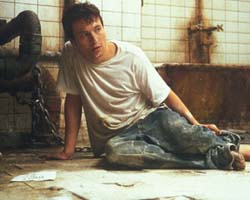 18) Saw
18) SawWhy it's on the list: For better or for worse, Saw has defined the decade in horror and the first film is still the best. Why you might be saying "Oh, hell no!": There have been so many lousy Saw sequels that you don't even remember the first one anymore. --In the last decade, no franchise has epitomized guilty pleasure quite like Saw. That's not necessarily a good thing, but it is worth noting. And not all of movies are pleasures, either, but it's fair to say each installment is an epileptic, over-stylized gore fest that serves almost no purpose than to make its audience feel tense, uneasy and grossed out. What can you say except there's an audience for it and what's kept it going are people's curiosities about the elaborate concoctions Jigsaw has in store for his victims. Ah, Jigsaw. He is the central villain in this stubbornly unsinkable series, dead or alive, and it's his sick motivations to teach people lessons that have churned out a new Saw movie every year for the past six years. What's interesting about Jigsaw is that he's not evil by nature; his mission is to inflict pain and suffering on those who have committed other sins, although not nearly as severe as Jigsaw will commit against them. He's like an early version of Dexter. The series' calling card, of course, is its extravagant and highly implausible death scenes, in which the victims are forced to sacrifice a part of themselves, or sometimes each other, to save their own lives. This can sometimes lead to sawing off your own arm or performing self-surgery to retrieve a key from your stomach that will unlock the machine that's bolted to your head, which will turn into a vice unless you remove it in time. All this sounds like torture porn, and that's what the Saw series has become, but the original from 2004 was more subdued and ambitious than its sequels. It remains a favorite among horror gurus not only because it was the first of its kind, but because it had a genuine, creepy atmosphere that made us feel unsettled and vulnerable (the sequels are more livid and unintentionally amusing). It is a sadistic horror movie that doubles as an effective police procedural, but it holds our attention because it does such a sensational job of manipulating us to the point where we become curious about Jigsaw's plans for the two guys he's got trapped in a room. The climactic ending, though completely contrived, has a disturbing, blindsiding effect that makes us want to retrace our steps and remember how we got there in the first place. It's hardly believable, but it's entertaining. Saw is not a great movie, and by no means did it spawn a great franchise, but the original is deviously well made and we feel like we're getting away with something by watching and enjoying it. It's a guilty pleasure for sure, but a pleasure nonetheless. Now if only the same could be written about the sequels. (Matthew Huntley/BOP) --October 1, 2004. I remember one of my lessons being cancelled, so I arrived home early. It meant I could catch the first showing of Saw. Lionsgate had decided to trial the film out in the UK a month before it opened anywhere else. I was working at an independent multiplex cinema at the time, and the film was playing in the smallest screen they had. Gory and chilling, here was a horror film that stood out from the crowd due to a genuinely clever script, with twists and turns that kept you guessing. Proof of strong word-of-mouth was witnessed over the coming weeks, as the late show of the film began to sell out every single night, and eventually the decision was made to move the film into a bigger screen. Admittedly, I consider Saw II equally as good, before the later sequels turned it into a soap opera slasher franchise. (Shalimar Sahota/BOP) --It's the film widely thought of as giving rise to the "torture porn" trend in American cinema. Rewatch the original Saw movie, though, and you'll find that's it's not nearly as gory as its successors, and works well as a thriller. The film not only launched the definitive horror series of the 2000s, but also gave audiences most ghoulish cinematic anti-hero since Freddy Kruger. The so-called Jigsaw Killer tests his victims' will - and worthiness - to keep living by subjecting them to grisly death traps. The audience squirms as each victim tries - or attempts to try - to take the unthinkably extreme measures necessary to survive Jigsaw's ghastly games. While the later films tended to employ gore for gore's sake, the original Saw film can be viewed as morality play - albeit a stomach-turning one. (Tony Kollath/BOP) --I have trouble reconciling the fact that only six years passed between the time that Saw debuted to sizzling word of mouth at Sundance to the point now where Saw 3D feels like the last gasp of a dead franchise. Let's put this in perspective for a moment. Saw the short action feature was created around the time the original list was published. In the interim, seven (!) different Saw movies have been released into theaters, earning $750 million along the way. Not coincidentally, each reposting of our original horror list was inevitably met with replies of, "Where's Saw?" Now that we are finally updating the selections for the 21st century, we are braced for the inevitable onslaught of "Why is Saw ranked so low?" with the honest answer that Saw fatigue set in long ago. Many of our voters do have a hard time separating the exemplary ideas in the original from the derivative sequels that were blatant cash grabs. I am not one of them, however, as I vividly recall how refreshing the first Saw was upon initial viewing. The premise of someone terrorizing people simply by pushing their boundaries is timeless, yet too-rarely implemented. I have even argued that Saw is somewhat of a logical successor to Speed in the way that ordinary people find themselves unwillingly thrust in the middle of an extraordinary event. What works for me about both stories is that the execution of both traps fails, making the villains more human in the process. There is of course a key difference in how the villains adapt to the changing circumstances and the reveal in Saw, one I deduced early on in the film, is satisfactory even if you expect it. The legend of Saw has been diminished over the years by lackluster sequels, but the original film still stands as one of the best psychological horror films ever made. (David Mumpower/BOP) Saw Trivia Quiz |
|
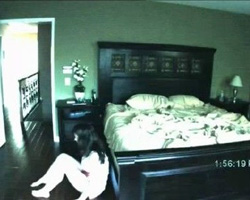 17) Paranormal Activity
17) Paranormal Activity Why it's on the list: This film gives us a second idea for how to use a camera in the bedroom. Why you might be saying "Oh, hell no!": 80 minutes of foreplay, but no orgasm at the end. Also, why is Micah so freakin' stupid? --Employing a minimum of cast members, shot on a shoestring budget and creatively marketed, 2006's Paranormal Activity recalled the success of The Blair Witch Project a few years earlier. This tale of a doomed couple attempting to survive in their increasingly haunted house scattered a heaping helping of terrifying scenes in its 86 minute run time. The movie scared its audience not only from its fright-inducing effects, but from the sense of dread that proceeded each one. While most of the hauntings were manifest at night, daytime provided little relief for either characters or audience, as the couple's deteriorating relationship ratcheted up the tension in the film. Let yourself get immersed in the film, and it's impossible not to stay up at night listening for the sounds of creaking through your house, and shiver a little at the macabre events that might be about to meet you. (Tony Kollath/BOP) --I am on record as saying that Paranormal Activity is one of the most impressive box office success stories of the 2000s. Despite the fact that we have the words box office right there in our URL, however, that has nothing to do with its selection to this list. The film belongs on the horror list for the obvious reason. It takes the same core premise of The Blair Witch Project, scaring the daylights out of regular people rather than having actors pretend to be scared, and it evolves from there, meticulously building a mystery that is satisfying in every way. Don't get me wrong. I know what the primary criticism is for this movie and I even agree with it. Paranormal Activity spends an hour freaking out the viewer, making them wonder what could possibly be the end game. And then we all realize that there is no end game. Several different attempts were made to create a satisfactory denoument and all of them fail. This doesn't matter to me. In fact, I was reminded of an old talk show appearance that Stephen King, the master of horror, did wherein he described a great idea for a story that he never finished. His premise was that men always look ridiculous as they wait outside the ladies room, impatiently and awkwardly pacing around as their dates freshen up. His idea would be for none of the women to come out of the bathroom, creating this foreboding sense of mystery for the reader about what in God's name could be swallowing up all of these women while their men are stranded outside. In the end, he never finished the story, because he couldn't think of a satisfactory resolution for such a clever concept. Thematically, this is exactly what Paranormal Activity is, an unsolved mystery that is terrifying even though it lacks that perfect solution that ties all of the pieces together. I view it as the horror equivalent of Memento in this regard. I may not like the ending, but getting there is such a thrill. As an aside, if you haven't watched the movie yet (and there are probably only a handful of you at this point), I would like to make a suggestion. My wife and I watched this movie late at night in our bed. That greatly enhanced the experience as we witnessed another couple alone late at night in their bed experience unimaginable terror. The symmetry exponentially improves the movie-watching experience. (David Mumpower/BOP) Paranormal Activity Trivia Quiz |
|
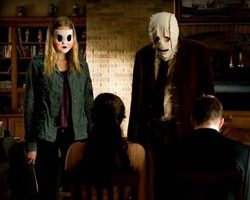 16) The Strangers
16) The StrangersWhy it's on the list: The nihilistic "explanation" for why the Strangers picked them makes us afraid to answer the door when someone knocks. Why you might be saying "Oh, hell no!": You're plenty anti-social enough without worrying about whether random strangers might show up and kill you. --The Strangers is exactly the sort of film that I did not expect to like. We all remember that for a brief period, the horror genre was little more than a series of attempts to outdo one another in terms of senseless violence. Whomever coined the term "gorno" really hit the bullseye. On its surface, I had dismissed The Strangers for being another corporate clone in this regard, a lazy excuse for a bloodbath, something that would be good for teens to make out during and little more. I was wrong. Loosely based on the premise of Helter Skelter, this is a tale of a vacationing couple who have attempted to get away from the world for a brief while. Little do they know that the world has followed them to the middle of nowhere and in their current location, there is nobody they can call for help. At its core, this is the genius of The Strangers. No matter where you go and what your intentions may be, there is always that possibility, no matter how remote, that some psychotic may take interest in you, that they may decide that their fun and games for the weekend will be hunting you for sport. This is a chilling premise, one that somehow simultaneously lingers in the realms of isolationism and unification. Without someone seeking isolation, there could be no sense of fulfillment for the trio of would-be assailants who have correctly deduced that this remote area is the perfect location for their unique brand of terror. Anyone can get to you at any time. That's a statement of fact, not one of paranoia. We all rely on certain societal laws in this regard. We believe that people will respect the laws of traffic. Otherwise, highways would be littered with the carnage of wrecked cars. We all trust that no one will come up to us and assault us on the street. Otherwise, violent anarchy would rule. And we all trust that in the comfort of our own homes, no one will attempt to kill us where we sleep. That's what makes The Strangers so chilling. We all live under this expectation that everyone will behave as society expects. This movie is an exercise in what happens when that basic tenet of interpersonal behavior is ignored. None of us believes that people in masks will come at us with knives, try to slaughter us for no other reason than that we were home. The Strangers is a demonstration that societal law is not universally respected and that none of us is as safe as we would like to believe. (David Mumpower/BOP) --News flash: Sinister people still find just as much enjoyment in slaying the innocent in a setting more intimate than the woods or some vacant warehouse. Like Halloween, The Strangers was made extra creepy by the fact that it had its team of bad guys set up shop in suburbia. So, it happened in a place not unlike your own neighborhood, or dwelling, or, more simply, the place you call home. It just doesn't get friendlier than that. (Well, maybe in the head – i.e. Freddy Krueger – but that's a matter of perspective). To set up the scary, the movie played off the idea that less is more. The soundtrack, for one, was brilliant because the movie barely had one at all. Instead of relying on crashing cymbals or quickened drum beats to raise the audience's respective blood pressures, much of the action was accompanied by the scene's natural sounds: A dude running across the grass. Doors opening any which way. Floorboards creaking from age and wear. Similarly, I enjoyed the subtleties in what was shown and not shown – and how much of the time we imagined what happened, instead of being force-fed meaningless gore. Like the scene when James pulls a Dick Cheney and shoots his friend in the face. We know it happened because we see the fallout, not because we see the blood fly and a chunk of Mike's face soar across the room. (Eric Hughes/BOP) The Strangers Trivia Quiz Read the Bride of Horror List Introduction Read selections 15-6 See selections 5-1 |
|

|
|
|

|
Thursday, October 31, 2024
© 2024 Box Office Prophets, a division of One Of Us, Inc.

